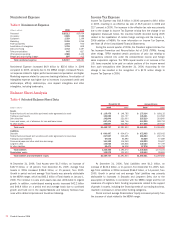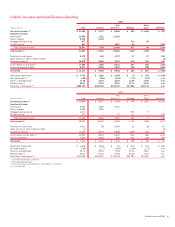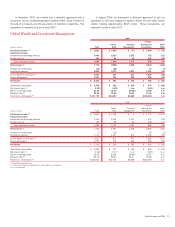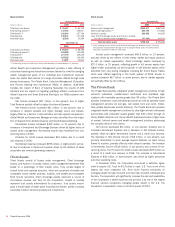Bank of America 2006 Annual Report Download - page 46
Download and view the complete annual report
Please find page 46 of the 2006 Bank of America annual report below. You can navigate through the pages in the report by either clicking on the pages listed below, or by using the keyword search tool below to find specific information within the annual report.The management accounting reporting process derives segment and
business results by utilizing allocation methodologies for revenue,
expense and capital. The Net Income derived for the businesses are
dependent upon revenue and cost allocations using an activity-based cost-
ing model, funds transfer pricing, other methodologies, and assumptions
management believes are appropriate to reflect the results of the busi-
ness.
The Corporation’s ALM activities maintain an overall interest rate risk
management strategy that incorporates the use of interest rate contracts
to minimize significant fluctuations in earnings that are caused by interest
rate volatility. The Corporation’s goal is to manage interest rate sensitivity
so that movements in interest rates do not significantly adversely affect
Net Interest Income. The results of the business segments will fluctuate
based on the performance of corporate ALM activities. Some ALM activ-
ities are recorded in the businesses (i.e., Deposits) such as external
product pricing decisions, including deposit pricing strategies, as well as
the effects of our internal funds transfer pricing process and other ALM
actions such as portfolio positioning. The net effects of other ALM activ-
ities are reported in each of the Corporation’s segments under ALM/Other.
In addition, any residual effect of the funds transfer pricing process is
retained in All Other.
Certain expenses not directly attributable to a specific business
segment are allocated to the segments based on pre-determined means.
The most significant of these expenses include data processing costs,
item processing costs and certain centralized or shared functions. Data
processing costs are allocated to the segments based on equipment
usage. Item processing costs are allocated to the segments based on the
volume of items processed for each segment. The costs of certain central-
ized or shared functions are allocated based on methodologies which
reflect utilization.
Equity is allocated to business segments and related businesses
using a risk-adjusted methodology incorporating each unit’s credit, market,
interest rate and operational risk components. The nature of these risks is
discussed further beginning on page 62. ROE is calculated by dividing Net
Income by average allocated equity. SVA is defined as cash basis earnings
on an operating basis less a charge for the use of capital (i.e., equity).
Cash basis earnings on an operating basis is defined as Net Income
adjusted to exclude Merger and Restructuring Charges and Amortization of
Intangibles. The charge for capital is calculated by multiplying 11 percent
(management’s estimate of the shareholders’ minimum required rate of
return on capital invested) by average total common shareholders’ equity
at the corporate level and by average allocated equity at the business
segment level. Average equity is allocated to the business level using a
methodology identical to that used in the ROE calculation. Management
reviews the estimate of the rate used to calculate the capital charge
annually. The Capital Asset Pricing Model is used to estimate our cost of
capital.
See Note 20 of the Consolidated Financial Statements for additional
business segment information, selected financial information for the busi-
ness segments and reconciliations to consolidated Total Revenue and Net
Income amounts.
44
Bank of America 2006
























